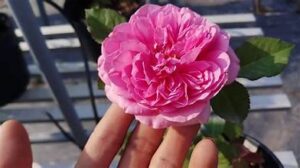### The Pompadour Rose and Color Variation: Influencing Factors

The Pompadour Rose, celebrated for its timeless beauty and elegance, captivates admirers with its stunning array of colors. However, the hues of this beloved flower are not static; they undergo fascinating transformations influenced by a multitude of factors. This article delves into the intricacies of Pompadour Rose color variation, exploring the genetic, environmental, and physiological factors that contribute to the mesmerizing palette of this iconic bloom.
#### Genetic Factors
Genetics play a fundamental role in determining the coloration of Pompadour Roses, as the genetic makeup of the plant dictates the production of pigments responsible for color expression.
1. **Genetic Variation and Breeding Programs**
– Pompadour Roses exhibit a wide range of colors, from delicate pastels to vibrant jewel tones, thanks to genetic variation within the species. Breeders selectively cross different rose varieties with desirable color traits to produce new cultivars with unique color profiles.
– Through hybridization and genetic manipulation techniques, breeders can introduce or enhance specific pigment pathways, leading to novel color variations. This process involves careful selection of parent plants with desired color characteristics and the use of advanced breeding methods to achieve desired outcomes.
2. **Inheritance Patterns**
– The inheritance of color traits in Pompadour Roses follows complex genetic patterns governed by multiple genes. Different alleles, or variants of genes, interact to produce various pigments and determine the final flower color.
– In some cases, color inheritance may follow simple Mendelian patterns, with dominant and recessive alleles dictating color expression. However, the inheritance of complex traits such as color intensity, hue, and patterning may involve polygenic inheritance, where multiple genes contribute to the phenotype.
3. **Mutations and Novel Variations**
– Spontaneous mutations can give rise to novel color variations in Pompadour Roses, leading to the discovery of unique cultivars with unexpected color traits. These mutations may alter the expression of pigment genes or affect other biochemical pathways involved in color formation.
– Breeders often identify and propagate mutant strains exhibiting desirable color characteristics, leading to the introduction of new rose varieties with distinct color profiles. These novel variations contribute to the diversity and richness of the Pompadour Rose color palette.
#### Environmental Influences
Environmental factors play a significant role in shaping the color expression of Pompadour Roses, as external conditions influence pigment production, accumulation, and stability.
1. **Light Exposure and Intensity**
– Light is a critical environmental factor that affects the color development of Pompadour Roses. Exposure to sunlight stimulates the production of pigments such as anthocyanins and carotenoids, which contribute to flower coloration.
– Variations in light intensity and duration can influence the synthesis and distribution of pigments within the petals, leading to differences in color saturation and brightness. Roses grown in full sunlight may exhibit more intense hues compared to those grown in shaded or partially shaded environments.
2. **Temperature and Climate**
– Temperature and climatic conditions also influence Pompadour Rose coloration, with optimal temperature ranges promoting pigment synthesis and stability. Cooler temperatures may enhance color intensity by slowing down pigment degradation processes, while excessive heat can lead to color fading or bleaching.
– Climate variations, including seasonal changes and regional differences, can impact the timing and duration of flower pigmentation processes. Roses grown in cooler climates may exhibit deeper and more vivid colors due to prolonged pigment accumulation periods during the growing season.
3. **Soil Composition and Nutrient Availability**
– Soil composition and nutrient availability play a role in supporting overall plant health and vigor, which indirectly influences Pompadour Rose coloration. Nutrient deficiencies or imbalances can affect pigment production and metabolic pathways involved in color formation.
– Soil pH levels also influence the availability of certain minerals and ions that interact with pigment molecules. Acidic soils may enhance the expression of certain pigments, leading to shifts in flower coloration, while alkaline soils may have the opposite effect.
#### Physiological Processes
The physiological processes occurring within Pompadour Rose petals govern color formation, development, and degradation, with biochemical pathways and enzymatic reactions driving pigment synthesis and transformation.
1. **Pigment Biosynthesis Pathways**
– Pompadour Rose coloration is primarily determined by the presence and distribution of pigments such as anthocyanins, carotenoids, and flavonoids within the petals. These pigments are synthesized through complex biochemical pathways involving enzymes and precursor molecules.
– Anthocyanins, responsible for red, purple, and blue hues, are synthesized via the phenylpropanoid pathway, with enzymes such as phenylalanine ammonia-lyase (PAL) and anthocyanidin synthase catalyzing key steps. Carotenoids, which produce yellow, orange, and red colors, are synthesized through the carotenoid biosynthesis pathway.
2. **pH-Dependent Color Changes**
– The pH environment within Pompadour Rose petals can influence pigment stability and color expression. Anthocyanin pigments, for example, undergo reversible changes in color based on pH levels, a phenomenon known as pH-dependent coloration.
– In acidic conditions, anthocyanins appear red or purple, while in alkaline environments, they may exhibit blue or violet hues. The pH sensitivity of anthocyanins allows for dynamic color changes in response to environmental factors such as soil pH, petal acidity, and cellular pH regulation.
3. **Pigment Degradation and Aging**
– Over time, Pompadour Rose petals undergo physiological changes associated with senescence and aging, leading to alterations in color and pigmentation patterns. Pigment degradation processes, including enzymatic reactions and oxidative stress, contribute to color fading and loss of vibrancy.
– Enzymes such as peroxidases and polyphenol oxidases catalyze the degradation of pigments, breaking down anthocyanins and carotenoids into colorless or less vibrant compounds. External factors such as exposure to ultraviolet (UV) radiation and environmental pollutants can accelerate pigment degradation and color changes.
#### Conclusion
The Pompadour Rose’s remarkable color variation is the result of a complex interplay between genetic, environmental, and physiological factors. Genetic variation within the species, influenced by breeding programs and spontaneous mutations, gives rise to diverse color profiles and novel cultivars.
Environmental conditions such as light exposure, temperature, and soil composition shape pigment production and distribution, impacting the intensity, hue, and stability of Pompadour Rose colors. Physiological processes within the petals, including pigment biosynthesis, pH-dependent color changes, and pigment degradation, further modulate color expression and dynamics.
By understanding the multifaceted influences on Pompadour Rose color variation, breeders, growers, and enthusiasts can appreciate the intricacies of this beloved flower’s chromatic palette. Whether admired for its delicate pastels or admired for its vibrant jewel tones, the Pompadour Rose continues to enchant with its captivating array of colors, a testament to nature’s enduring beauty and diversity.
### The Pompadour Rose and Color Variation: Influencing Factors (Part 2)
Continuing our exploration of the factors influencing color variation in the Pompadour Rose, we delve deeper into the role of environmental conditions, cultural practices, and physiological responses in shaping the mesmerizing hues of this iconic flower.
#### Environmental Conditions
1. **Light Exposure and Photoperiodism**
– Light exposure plays a crucial role in regulating physiological processes in Pompadour Roses, including color development. Photoperiodism, the plant’s response to changes in day length, influences flowering and pigment production.
– Longer daylight hours during the growing season stimulate photosynthesis and pigment synthesis, leading to the accumulation of anthocyanins and carotenoids in rose petals. Conversely, shorter days trigger dormancy and may result in reduced pigment production.
2. **Temperature Fluctuations**
– Temperature fluctuations impact Pompadour Rose coloration by influencing metabolic pathways and enzyme activity. Cooler temperatures promote anthocyanin accumulation, resulting in deeper and more vibrant hues, while warmer temperatures may inhibit pigment synthesis.
– Extreme temperature fluctuations, such as sudden frosts or heatwaves, can stress the plant and disrupt pigment formation processes, leading to color variations and inconsistencies.
3. **Soil Composition and Nutrient Availability**
– Soil composition and nutrient availability affect the overall health and vigor of Pompadour Roses, indirectly influencing color expression. Nutrient deficiencies or imbalances can impede pigment synthesis and result in pale or faded colors.
– Organic matter, such as compost and mulch, can improve soil structure and nutrient retention, enhancing the availability of essential minerals for optimal rose growth and color development.
#### Cultural Practices
1. **Pruning and Training Techniques**
– Pruning and training techniques employed by growers can influence Pompadour Rose coloration by altering plant physiology and flower development. Pruning stimulates new growth and encourages the production of vigorous, colorful blooms.
– Strategic pruning can also improve air circulation and light penetration, ensuring uniform color development and minimizing the risk of disease or pest infestation.
2. **Fertilization and Soil Amendments**
– Proper fertilization and soil amendments are essential for maintaining healthy Pompadour Rose plants and promoting vibrant coloration. Balanced fertilizers provide essential nutrients such as nitrogen, phosphorus, and potassium, which are critical for pigment synthesis and flower formation.
– Organic soil amendments, such as compost and manure, enrich the soil with organic matter and beneficial microorganisms, enhancing nutrient uptake and supporting overall plant health.
3. **Watering Practices**
– Adequate watering is crucial for Pompadour Rose color development, as water stress can impact flower quality and pigment expression. Consistent soil moisture levels support optimal nutrient uptake and metabolic processes.
– Drip irrigation systems or soaker hoses deliver water directly to the root zone, minimizing water waste and reducing the risk of fungal diseases associated with overhead watering.
#### Physiological Responses
1. **Anthocyanin Accumulation and pH**
– Anthocyanin pigments, responsible for red, purple, and blue hues in Pompadour Roses, undergo pH-dependent color changes. In acidic environments, anthocyanins appear red or purple, while alkaline conditions may result in blue or violet hues.
– pH levels within the rose petals can fluctuate in response to environmental factors such as soil pH, water quality, and cellular metabolism, influencing the final coloration of the flowers.
2. **Antioxidant Activity and Stress Responses**
– Pompadour Roses produce antioxidants, such as flavonoids and phenolic compounds, in response to environmental stressors such as UV radiation, heat, and drought. These antioxidants help protect the plant from oxidative damage and enhance color stability.
– Environmental stressors can trigger physiological responses in Pompadour Roses, including the production of stress-related hormones and signaling molecules that regulate pigment synthesis and accumulation.
3. **Senescence and Aging**
– As Pompadour Rose flowers mature and senesce, changes in pigment composition and cellular physiology contribute to color fading and petal degradation. Enzymatic reactions and oxidative processes break down pigments, resulting in color changes and loss of vibrancy.
– Ethylene, a plant hormone involved in senescence and fruit ripening, accelerates the degradation of pigments and hastens flower wilting. Proper post-harvest handling and storage practices can prolong the shelf life and color retention of cut Pompadour Roses.
#### Conclusion
The captivating color variation exhibited by Pompadour Roses is the result of a complex interplay between genetic, environmental, cultural, and physiological factors. From genetic inheritance and environmental influences to cultural practices and physiological responses, each factor contributes to the diverse and dynamic palette of colors observed in this iconic flower.
By understanding the multifaceted influences on Pompadour Rose coloration, growers, breeders, and enthusiasts can implement targeted strategies to enhance color development, improve flower quality, and preserve the natural beauty of this cherished bloom. Whether admired for their delicate pastels or prized for their vibrant jewel tones, Pompadour Roses continue to enchant and inspire with their captivating array of colors, a testament to nature’s endless creativity and resilience.


